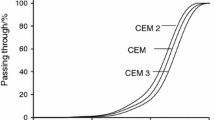Abstract
Thermogravimetry (TG) and derivative thermogravimetry (DTG) have been used by the authors as very effective tools to study hydration steps of cements used for solidification/stabilization of tanning wastes. The present paper presents a method which was applied to separate the peaks shown by DTG curves of type II Portland cement pastes, analyzed at different times during the first 4 weeks of setting. Through a specific software a more detailed study of the evolution of the cement hydration may be done, which allows the measurement of the amount of hydrated water present in tobermorite gel as well as in ettringite, which are the main phases formed from the original components of the cement. The number of moles of water present in the ettringite phase calculated by the method is in very good agreement with the values found in the literature, validating the method to calculate the same parameter in tobermorite gel. In the latter case the water content decreases significantly during the first day of hydration, then remains at a constant value over the rest of the analyzed period.
Similar content being viewed by others
References
J. Dweck, P. M. Buchler, A. C. V. Coelho and F. K. Cartledge, J. Environ. Sci. Health, A35 (2000) 715.
J. Dweck, P. M. Buchler, A. C. V. Coelho and F. K. Cartledge, Thermochim. Acta, 346 (2000) 105.
J. Dweck, P. M. Buchler, A. C. V. Coelho and F. Cartledge, Proc. 43 Congr. Bras. Ceram., (1999) 37901.
J. Dweck, P. M. Buchler and F. K. Cartledge, J. Therm. Anal. Cal., 64 (2001) 1011.
F. Guirado, S. Galí and J. S. Chinchón., Cem. Concr. Res., 28 (1998) 381.
C. S. Poon, A. I. Clark, C. J. Peter and R. Perry, Waste Manag. and Res., 3 (1985) 127.
G. J. McCarthy, D. J. Hassett and J. A. Bender, Mat. Res. Soc. Symp. Proc., 245 (1992) 129.
S. J. T. Pollard, C. D. Hills and J. Kennedy, Envir. Tech., 15 (1994) 617.
M. Y. A. Mollah, F. Lu and D. L. Cocke, Sci. Tot. Envir., 224 (1998) 57.
Lafarge, Materials to Build the World, Lafarge Publication, Rio de Janeiro 1998.
Comité Européen de Normalization (CEN), Ciment Betons Platres Chaux, 795 (1992) 118.
SPSS Inc. Peak Fit User’s Manual, Chicago, SPSS Inc. Publication 1997.
Lea’s Chemistry of Cement and Concrete, 4th Ed. Arnold, London 1998, p. 134.
V. S. Ramachandran, Applications of Differential Thermal Analysis in Cement Chemistry, Chemical Publishing Co., New York 1969, p. 92.
Author information
Authors and Affiliations
Corresponding author
Rights and permissions
About this article
Cite this article
Dweck, J., Ferreira da Silva, P.F., Büchler, P.M. et al. Study by thermogravimetry of the evolution of ettringite phase during type II Portland cement hydration. Journal of Thermal Analysis and Calorimetry 69, 179–186 (2002). https://doi.org/10.1023/A:1019950126184
Issue Date:
DOI: https://doi.org/10.1023/A:1019950126184




